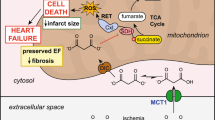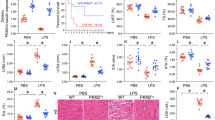Abstract
Catestatin (CST) limits myocardial ischaemia/reperfusion (I/R) injury with unknown mechanisms. Clearly phosphoinositide-3-kinase (PI3K), protein kinase C (PKC) isoforms, including intra-mitochondrial PKCε, mitochondrial KATP (mitoKATP) channels and subsequent reactive oxygen species (ROS)-signalling play important roles in postconditioning cardioprotection, preventing mitochondrial permeability transition pore (mPTP) opening. Therefore, we studied the role of these extra- and intra-mitochondrial factors in CST-induced protection. Isolated rat hearts and H9c2 cells underwent I/R and oxidative stress, respectively. In isolated hearts CST (75nM, CST-Post) given in early-reperfusion significantly reduced infarct size, limited post-ischaemic contracture, and improved recovery of developed left ventricular pressure. PI3K inhibitor, LY-294002 (LY), large spectrum PKC inhibitor, Chelerythrine (CHE), specific PKCε inhibitor (εV1-2), mitoKATP channel blocker, 5-Hydroxydecanoate (5HD) or ROS scavenger, 2-mercaptopropionylglycine (MPG) abolished the infarct-sparing effect of CST. Notably the CST-induced contracture limitation was maintained during co-infusion of 5HD, MPG or εV1-2, but it was lost during co-infusion of LY or CHE. In H9c2 cells challenged with H2O2, mitochondrial depolarization (an index of mPTP opening studied with JC1-probe) was drastically limited by CST (75nM). Our results suggest that the protective signalling pathway activated by CST includes mitoKATP channels, ROS signalling and prevention of mPTP opening, with a central role for upstream PI3K/Akt and PKCs. In fact, all inhibitors completely abolished CST-infarct-sparing effect. Since CST-anti-contracture effect cannot be explained by intra-mitochondrial mechanisms (PKCε activation and mitoKATP channel opening) or ROS signalling, it is proposed that these downstream signals are part of a reverberant loop which re-activates upstream PKCs, which therefore play a pivotal role in CST-induced protection.




Similar content being viewed by others
References
Angelone T, Filice E, Quintieri AM et al (2008) Beta3-adrenoceptors modulate left ventricular relaxation in the rat heart via the NO-cGMP-PKG pathway. Acta Physiol (Oxf) 193:229–239. doi:10.1111/j.1748-1716.2008.01838.x
Angelone T, Mazza R, Cerra MC (2012) Chromogranin-A: a multifaceted cardiovascular role in health and disease. Curr Med Chem 19:4042–4050. doi:10.2174/092986712802430009
Angelone T, Quintieri AM, Brar BK et al (2008) The antihypertensive chromogranin A peptide catestatin acts as a novel endocrine/paracrine modulator of cardiac inotropism and lusitropism. Endocrinology 149:4780–4793. doi:10.1210/en.2008-0318
Angelone T, Quintieri AM, Pasqua T et al (2012) Phosphodiesterase type-2 and NO-dependent S-Nitrosylation mediate the cardioinhibition of the anti-hypertensive Catestatin. Am J Physiol Heart Circ Physiol 302:H431–H442. doi:10.1152/ajpheart.00491.2011
Baker JE, Konorev EA, Gross GJ, Chilian WM, Jacob HJ (2000) Resistance to myocardial ischaemia in five rat strains: is there a genetic component of cardioprotection? Am J Physiol Heart Circ Physiol 278:H1395–H1400
Bassino E, Fornero S, Gallo MP et al (2011) A novel Catestatin induced antiadrenergic mechanism triggered by the endothelial PI3K-eNOS pathway in the myocardium. Cardiovasc Res 91:617–624. doi:10.1093/cvr/cvr129
Boengler K, Heusch G, Schulz R (2011) Mitochondria in postconditioning. Antioxid Redox Signal 14:863–880. doi:10.1089/ars.2010.3309
Brar BK, Helgeland E, Mahata SK et al (2010) Human catestatin peptides differentially regulate infarct-size in the ischaemic-reperfused rat heart. Regul Pept 165:63–70. doi:10.1016/j.regpep.2010.07.153
Budas GR, Churchill EN, Disatnik MH, Sun L, Mochly-Rosen D (2010) Mitochondrial import of PKCepsilon is mediated by HSP90: a role in cardioprotection from ischaemia and reperfusion injury. Cardiovasc Res 88:83–92. doi:10.1093/cvr/cvq154
Cappello S, Angelone T, Tota B et al (2007) Human recombinant chromogranin A-derived vasostatin-1 mimics preconditioning via an adenosine/nitric oxide signaling mechanism. Am J Physiol Heart Circ Physiol 293:H719–H127. doi:10.1152/ajpheart.01352.2006
Ceconi C, Ferrari R, Bachetti T et al (2002) Chromogranin A in heart failure; a novel neurohumoral factor and a predictor for mortality. Eur Heart J 23:967–974. doi:10.1053/euhj.2001.2977
Cerra MC, Gallo MP, Angelone T et al (2008) The homologous rat chromogranin A1-64 (rCgA1-64) modulates myocardial and coronary function in rat heart to counteract adrenergic stimulation indirectly via endothelium-derived nitric oxide. FASEB J 22:3992–4004. doi:10.1096/fj.08-110239
Cohen MV, Downey JM (2011) Ischaemic postconditioning: from receptor to end-effector. Antioxid Redox Signal 14:821–831. doi:10.1089/ars.2010.3318
Cohen MV, Yang XM, Downey JM (2007) The pH hypothesis of postconditioning: staccato reperfusion reintroduces oxygen and perpetuates myocardial acidosis. Circulation 115:1895–1903. doi:10.1161/CIRCULATIONAHA.106.675710
Costa AD, Garlid KD (2008) Intramitochondrial signaling: interactions among mitoKATP, PKCepsilon, ROS, and MPT. Am J Physiol Heart Circ Physiol 295:H874–H882. doi:10.1152/ajpheart.01189.2007
Fung MM, Salem RM, Mehtani P et al (2010) Direct vasoactive effects of the chromogranin A (CHGA) peptide catestatin in humans in vivo. Clin Exp Hypertens 32:278–287. doi:10.3109/10641960903265246
Gaede AH, Pilowsky PM (2011) Catestatin, a chromogranin A derived peptide, is sympathoinhibitory and attenuates sympathetic barosensitivity and the chemoreflex in rat CVLM. Am J Physiol Regul Integr Comp Physiol 302:R365–R372. doi:10.1152/ajpregu.00409.2011
Hausenloy DJ, Lecour S, Yellon DM (2011) Reperfusion injury salvage kinase and survivor activating factor enhancement prosurvival signaling pathways in ischaemic postconditioning: two sides of the same coin. Antioxid Redox Signal 14:893–907. doi:10.1089/ars.2010.3360
Helle KB (2010) The chromogranin A-derived peptides vasostatin-I and catestatin as regulatory peptides for cardiovascular functions. Cardiovasc Res 85:9–16. doi:10.1093/cvr/cvp266
Ihara Y, Urata Y, Goto S, Kondo T (2006) Role of calreticulin in the sensitivity of myocardiac H9c2 cells to oxidative stress caused by hydrogen peroxide. Am J Physiol Cell Physiol 290:C208–C221. doi:10.1152/ajpcell.00075.2005
Ivanès F, Rioufol G, Piot C, Ovize M (2011) Postconditioning in acute myocardial infarction patients. Antioxid Redox Signal 14:811–820. doi:10.1089/ars.2010.3354
Jansson AM, Røsjø H, Omland T et al (2009) Prognostic value of circulating chromogranin A levels in acute coronary syndromes. Eur Heart J 30:25–32. doi:10.1093/eurheartj/ehn513
Kennedy BP, Mahata SK, O'Connor DT, Ziegler MG (1998) Mechanism of cardiovascular actions of the chromogranin A fragment catestatin in vivo. Peptides 19:1241–1248. doi:10.1016/S0196-9781(98)00086-2
Leary PJ, Rajasekaran S, Morrison RR, Tuomanen EI, Chin TK, Hofmann PA (2008) A cardioprotective role for platelet-activating factor through NOS-dependent S-nitrosylation. Am J Physiol Heart Circ Physiol 294:H2775–H2784. doi:10.1152/ajpheart.00269.2008
Liu J, Mao W, Ding B, Liang CS (2008) ERKs/p53 signal transduction pathway is involved in doxorubicin-induced apoptosis in H9c2 cells and cardiomyocytes. Am J Physiol Heart Circ Physiol 295:H1956–H1965. doi:10.1152/ajpheart.00407.2008
Liu Y, Yang XM, Iliodromitis EK et al (2008) Redox signaling at reperfusion is required for protection from ischemic preconditioning but not from a direct PKC activator. Basic Res Cardiol 103:54–59. doi:10.1007/s00395-007-0683-y
Mahapatra NR (2008) Catestatin is a novel endogenous peptide that regulates cardiac function and blood pressure. Cardiovasc Res 80:330–338. doi:10.1093/cvr/cvn155
Mahapatra NR, O'Connor DT, Vaingankar SM et al (2005) Hypertension from targeted ablation of chromogranin A can be rescued by the human ortholog. J Clin Invest 115:1942–1952. doi:10.1172/JCI24354
Mahata SK, Mahata M, Fung MM, O'Connor DT (2010) Catestatin: a multifunctional peptide from chromogranin A. Regul Pept 162:33–43. doi:10.1016/j.regpep.2010.09.007
Nadtochiy SM, Burwell LS, Brookes PS (2007) Cardioprotection and mitochondrial S-nitrosation: effects of S-nitroso-2-mercaptopropionyl glycine (SNO-MPG) in cardiac ischemia-reperfusion injury. J Mol Cell Cardiol 42:812–825. doi:10.1016/j.yjmcc.2007.01.010
Nishida H, Sato T, Ogura T, Nakaya H (2009) New aspects for the treatment of cardiac diseases based on the diversity of functional controls on cardiac muscles: mitochondrial ion channels and cardioprotection. J Pharmacol Sci 109:341–347. doi:10.1254/jphs.08R24FM
O'Connor DT, Kailasam MT, Kennedy BP, Ziegler MG, Yanaihara N, Parmer RJ (2002) Early decline in the catecholamine release-inhibitory peptide catestatin in humans at genetic risk of hypertension. J Hypertens 20:1335–1345
Pagliaro P, Mancardi D, Rastaldo R et al (2003) Nitroxyl affords thiol-sensitive myocardial protective effects akin to early preconditioning. Free Radic Biol Med 34:33–43. doi:10.1016/S0891-5849(02)01179-6
Pagliaro P, Moro F, Tullio F, Perrelli M-G, Penna C (2011) Cardioprotective pathways during reperfusion: focus on redox signaling and other modalities of cell signaling. Antioxid Redox Signal 14:833–850. doi:10.1089/ars.2010.3245
Penna C, Alloatti G, Cappello S et al (2005) Platelet-activating factor induces cardioprotection in isolated rat heart akin to ischaemic preconditioning: role of phosphoinositide 3-kinase and protein kinase C activation. Am J Physiol Heart Circ Physiol 288:H2512–H2520. doi:10.1152/ajpheart.00599.2004
Penna C, Alloatti G, Gallo MP et al (2010) Catestatin improves post-ischaemic left ventricular function and decreases ischaemia/reperfusion injury in heart. Cell Mol Neurobiol 30:1171–1179. doi:10.1007/s10571-010-9552-6
Penna C, Bassino E, Alloatti G (2011) Platelet activating factor: the good and the bad in the ischaemic/reperfused heart. Exp Biol Med (Maywood) 236:390–401. doi:10.1258/ebm.2011.010316
Penna C, Mancardi D, Raimondo S, Geuna S, Pagliaro P (2008) The paradigm of postconditioning to protect the heart. J Cell Mol Med 12:435–458. doi:10.1111/j.1582-4934.2007.00210.x
Penna C, Mancardi D, Rastaldo R, Losano G, Pagliaro P (2007) Intermittent activation of bradykinin B2 receptors and mitochondrial KATP channels trigger cardiac postconditioning through redox signaling. Cardiovasc Res 75:168–177. doi:10.1016/j.cardiores.2007.03.001
Penna C, Perrelli MG, Tullio F et al (2011) Postischaemic early acidosis in cardiac postconditioning modifies the activity of antioxidant enzymes, reduces nitration, and favors protein S-nitrosylation. Pflugers Arch 462:219–233. doi:10.1007/s00424-011-0970-1
Penna C, Rastaldo R, Mancardi D et al (2006) Post-conditioning induced cardioprotection requires signaling through a redox-sensitive mechanism, mitochondrial ATP-sensitive K+ channel and protein kinase C activation. Basic Res Cardiol 101:180–189. doi:10.1007/s00395-006-0584-5
Philipp S, Yang XM, Cui L, Davis AM, Downey JM, Cohen MV (2006) Postconditioning protects rabbit hearts through a protein kinase C-adenosine A2b receptor cascade. Cardiovasc Res 70:308–314. doi:10.1016/j.cardiores.2006.02.014
Pieroni M, Corti A, Tota B et al (2007) Myocardial production of chromogranin A in human heart: a new regulatory peptide of cardiac function. Eur Heart J 28:1117–1127. doi:10.1093/eurheartj/ehm022
Pravdic D, Sedlic F, Mio Y et al (2009) Anesthetic-induced preconditioning delays opening of mitochondrial permeability transition pore via protein Kinase C-epsilon-mediated pathway. Anesthesiology 111:267–274. doi:10.1097/ALN.0b013e3181a91957
Rana P, Nadanaciva S, Will Y (2011) Mitochondrial membrane potential measurement of H9c2 cells grown in high-glucose and galactose-containing media does not provide additional predictivity towards mitochondrial assessment. Toxicol In Vitro 25:580–587. doi:10.1016/j.tiv.2010.11.016
Sathishkumar K, Gao X, Raghavamenon AC et al (2010) Determination of glutathione, mitochondrial transmembrane potential, and cytotoxicity in H9c2 cardiomyoblasts exposed to reactive oxygen and nitrogen species. Methods Mol Biol 610:51–61. doi:10.1007/978-1-60327-029-8_4
Shi J, Xu J, Zhang X, Yang L (2012) Positive feedback induced memory effect in ischemic preconditioning. J Theor Biol 300:317–323. doi:10.1016/j.jtbi.2012.01.033
Sivaraman V, Mudalgiri NR, Di Salvo C et al (2007) Postconditioning protects human atrial muscle through the activation of the RISK pathway. Basic Res Cardiol 102:453–459. doi:10.1007/s00395-007-0664-1
Sun HY, Wang NP, Kerendi F et al (2005) Hypoxic postconditioning reduces cardiomyocyte loss by inhibiting ROS generation and intracellular Ca2+ overload. Am J Physiol Heart Circ Physiol 288:H1900–H1908. doi:10.1152/ajpheart.01244.2003
Theurl M, Schgoer W, Albrecht K et al (2010) The neuropeptide catestatin acts as a novel angiogenic cytokine via a basic fibroblast growth factor-dependent mechanism. Circ Res 107:1326–1335. doi:10.1161/CIRCRESAHA.110.219493
Thuc LC, Teshima Y, Takahashi N et al (2010) Mitochondrial K(ATP) channels-derived reactive oxygen species activate pro-survival pathway in pravastatin-induced cardioprotection. Apoptosis 15:669–678. doi:10.1007/s10495-010-0473-0
Tsutsumi YM, Yokoyama T, Horikawa Y et al (2007) Reactive oxygen species trigger ischemic and pharmacological postconditioning: in vivo and in vitro characterization. Life Sci 81:1223–12237. doi:10.1016/j.lfs.2007.08.031
Vinten-Johansen J, Granfeldt A, Mykytenko J et al (2011) The multidimensional physiological responses to postconditioning. Antioxid Redox Signal 14:791–810. doi:10.1089/ars.2010.3396
Wang X, Willenbring H, Akkari Y et al (2003) Cell fusion is the principal source of bone-marrow-derived hepatocytes. Nature 422:897–901. doi:10.1038/nature01531
Wang X, Xu S, Liang Y et al (2011) Dramatic changes in catestatin are associated with hemodynamics in acute myocardial infarction. Biomarkers 16:372–377. doi:10.3109/1354750X.2011.578260
Zatta AJ, Kin H, Lee G et al (2006) Infarct-sparing effect of myocardial postconditioning is dependent on protein kinase C signaling. Cardiovasc Res 70:315–324. doi:10.1016/j.cardiores.2005.11.030
Acknowledgments
The authors wish to thank Prof. Donatella Gattullo for insightful suggestions, and Dr. Sushil K. Mahata for providing us with CST. This work was supported by National Institute for Cardiovascular Research (INRC-2010, to BT, GA, MCC, PP); Regione Piemonte (CP, GA, PP), ex-60 % (CP, PP, GA) and PRIN-2008 (BT, CP).
Conflict of interest
None declared.
Author information
Authors and Affiliations
Corresponding authors
Additional information
Maria-Giulia Perrelli and Francesca Tullio contributed equally to this work
Rights and permissions
About this article
Cite this article
Perrelli, MG., Tullio, F., Angotti, C. et al. Catestatin reduces myocardial ischaemia/reperfusion injury: involvement of PI3K/Akt, PKCs, mitochondrial KATP channels and ROS signalling. Pflugers Arch - Eur J Physiol 465, 1031–1040 (2013). https://doi.org/10.1007/s00424-013-1217-0
Received:
Revised:
Accepted:
Published:
Issue Date:
DOI: https://doi.org/10.1007/s00424-013-1217-0




